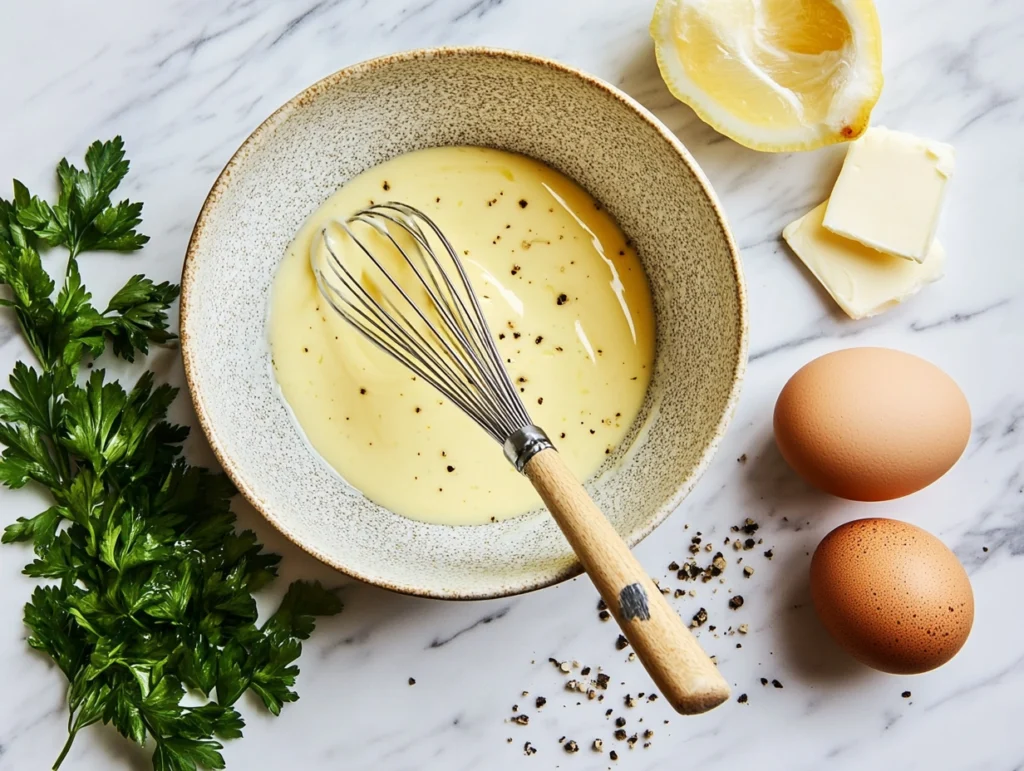1. Introduction
Eggs Benedict is one of the most iconic dishes in the world of brunch. With its luxurious combination of poached eggs, Canadian bacon, creamy Hollandaise sauce, and a perfectly toasted English muffin, it’s no surprise this dish has become synonymous with indulgence. Whether enjoyed in a bustling restaurant or prepared in the comfort of home, Eggs Benedict stands out as a true celebration of culinary excellence.

Alt Text: Classic Eggs Benedict served with Hollandaise sauce on a rustic wooden table, garnished with parsley.
This classic dish isn’t just about flavor—it represents a history of refinement, creativity, and tradition. For many, it’s the pinnacle of a weekend brunch menu. The combination of textures and tastes—from the velvety sauce to the runny egg yolk—is both comforting and sophisticated, making it an enduring favorite. This guide dives deep into the origins, components, preparation techniques, and creative variations of Eggs Benedict. Whether you’re a seasoned chef or a brunch enthusiast, this article will leave you inspired to master this beloved dish.
2. History of Eggs Benedict
2.1 Origin Theories
The history of Eggs Benedict is as rich as the dish itself. Its origins are steeped in fascinating stories, each adding a layer of intrigue to its creation. Here are three widely known theories:
2.1.1 Delmonico’s Restaurant Claim
One of the earliest accounts of Eggs Benedict’s invention comes from Delmonico’s Restaurant in New York City. It is said that in the 1860s, a customer named Mrs. LeGrand Benedict, tired of the usual menu items, approached the chef, Charles Ranhofer, for something different. In response, he created what we now recognize as Eggs Benedict. Ranhofer even published the recipe in his 1894 cookbook, The Epicurean, solidifying its place in culinary history.
2.1.2 Waldorf Hotel Anecdote
Another popular origin story centers around Lemuel Benedict, a retired Wall Street broker. In 1894, while dining at the Waldorf Hotel, he requested a dish to cure his hangover: buttered toast, poached eggs, crispy bacon, and Hollandaise sauce. The hotel’s chef was so impressed by the combination that he refined it by replacing the toast with an English muffin and the bacon with Canadian bacon, officially adding it to the menu.
2.1.3 Commodore E.C. Benedict’s Recipe
A less common but equally compelling tale credits Commodore E.C. Benedict, a prominent banker and yachtsman, with the creation of the dish. His recipe, shared with friends and later published in a magazine, featured many of the elements we associate with Eggs Benedict today.
2.2 Evolution Over Time
From its supposed debut in high-end New York restaurants, Eggs Benedict has undergone numerous transformations. What started as a simple yet elegant dish has now become a canvas for culinary experimentation. Modern variations incorporate global flavors and innovative ingredients, showcasing the versatility and timelessness of this classic.
3. Components of Eggs Benedict
The brilliance of Eggs Benedict lies in the harmony of its components. Each element plays a vital role in creating the dish’s iconic flavor and texture profile. Let’s delve into what makes up this classic recipe.
3.1 English Muffin
The base of Eggs Benedict is a halved and toasted English muffin. This bread is light, slightly chewy, and porous, making it perfect for soaking up the runny egg yolk and Hollandaise sauce. Toasting the muffin adds a slight crispiness that balances the softer components of the dish. While traditional recipes call for the classic white English muffin, whole wheat or gluten-free alternatives have become popular among those seeking a healthier or diet-friendly option.
3.2 Canadian Bacon
Canadian bacon is the traditional protein in Eggs Benedict. Its slightly smoky, salty flavor complements the rich Hollandaise sauce and poached egg. Unlike streaky bacon, Canadian bacon is lean and meaty, providing a firmer texture. Variations often substitute Canadian bacon with smoked salmon, avocado, or even crispy pancetta for a different flavor twist.
3.3 Poached Eggs
At the heart of Eggs Benedict are the poached eggs. The goal is to achieve a delicate white exterior encasing a perfectly runny yolk. When cut into, the yolk flows onto the other ingredients, creating a sauce-like effect that enhances every bite. The art of poaching eggs involves patience and technique, requiring precise water temperature and gentle handling to ensure success.
3.4 Hollandaise Sauce
Perhaps the most iconic component, Hollandaise sauce is a luxurious emulsion of egg yolks, butter, and lemon juice. Its creamy texture and tangy flavor tie the entire dish together. The sauce’s subtle richness elevates the other components, making each bite indulgent. When asked, “What does Hollandaise sauce taste like?”, the answer is a balance of buttery richness and a hint of citrusy brightness.
4. Preparing the Perfect Eggs Benedict
Making Eggs Benedict from scratch may seem intimidating, but with the right techniques, it’s a rewarding experience. Here’s a step-by-step guide to mastering this classic dish.

Alt Text: Hollandaise sauce being whisked in a bowl with fresh ingredients like eggs, butter, and lemon on a marble countertop.
4.1 Toasting the English Muffin
- Begin by slicing the English muffins in half.
- Lightly butter each side and place them on a skillet or under a broiler.
- Toast until golden brown and crisp on the edges. This creates a sturdy base for layering the other ingredients.
4.2 Cooking Canadian Bacon
- Heat a skillet over medium heat and cook the Canadian bacon slices for about 1-2 minutes per side.
- Aim for a slight sear to enhance the flavor without overcooking, ensuring the bacon remains tender.
4.3 Poaching Eggs
Perfectly poached eggs are the hallmark of Eggs Benedict. Follow these steps for consistent results:
- Fill a medium saucepan with water and bring it to a gentle simmer.
- Add a splash of vinegar to help the egg whites coagulate.
- Crack each egg into a small bowl for easy transfer.
- Create a gentle whirlpool in the water and slide the egg into the center.
- Cook for 3-4 minutes until the whites are set but the yolk remains runny. Remove with a slotted spoon and drain on a paper towel.
4.4 Making Hollandaise Sauce
- Melt 1/2 cup of unsalted butter and keep it warm.
- In a heatproof bowl, whisk together 3 egg yolks and a tablespoon of lemon juice.
- Place the bowl over a pot of simmering water, ensuring it doesn’t touch the water. Whisk constantly until the mixture thickens.
- Slowly drizzle in the melted butter while continuing to whisk. Season with a pinch of salt and cayenne pepper.
- If the sauce thickens too much, thin it with a teaspoon of warm water.
4.5 Assembling the Dish
- Start with the toasted English muffin halves as the base.
- Place a slice of Canadian bacon on each muffin.
- Gently add the poached egg on top of the bacon.
- Finish by spooning warm Hollandaise sauce over the eggs, allowing it to cascade over the sides. Garnish with a sprinkle of fresh parsley or paprika for a pop of color.
5. Variations of Eggs Benedict
One of the reasons Eggs Benedict remains so beloved is its versatility. Over time, chefs and home cooks have created countless variations, each with its unique twist on the classic recipe. Here are some popular variations and creative ideas to inspire your next brunch.

Alt Text: Eggs Benedict variation with smoked salmon, Hollandaise sauce, and fresh dill served with mimosa and fruit salad.
5.1 Eggs Florentine
Eggs Florentine replaces the Canadian bacon with sautéed spinach, offering a vegetarian option with a hint of earthiness. The spinach is usually cooked with garlic and a touch of olive oil, adding a flavorful and nutrient-packed alternative. This variation pairs wonderfully with the creamy Hollandaise sauce, creating a dish that feels lighter yet equally indulgent.
5.2 Eggs Royale
For seafood lovers, Eggs Royale swaps the Canadian bacon for smoked salmon. The smoky, salty flavor of the salmon pairs perfectly with the tangy Hollandaise sauce and poached egg. This variation often includes a sprinkle of fresh dill or capers for added flavor. It’s a luxurious take on the classic, perfect for special occasions.
5.3 Eggs Sardou
Eggs Sardou is a New Orleans-inspired variation that replaces the traditional components with creamed spinach, artichoke bottoms, and béarnaise sauce. This dish is rich, decadent, and bursting with flavor, showcasing the culinary creativity of the Southern United States.
5.4 Eggs Blackstone
Eggs Blackstone adds a fresh twist by incorporating sliced tomatoes and crispy bacon instead of Canadian bacon. The tomatoes add a juicy, slightly acidic note that balances the richness of the dish, while the crispy bacon provides a satisfying crunch.
5.5 Regional Twists
- Southern Benedict: A hearty version featuring buttermilk biscuits instead of English muffins and pulled pork as the protein. Often topped with a spicy Hollandaise or gravy for a Southern flair.
- Huevos Benedictos: This Mexican-inspired variation incorporates chorizo, avocado, and a drizzle of salsa or chipotle Hollandaise. It’s a bold and flavorful twist that adds a hint of spice.
- Irish Benedict: Corned beef or Irish bacon replaces the Canadian bacon, and the dish is often served with soda bread. This variation is popular on St. Patrick’s Day or in Irish pubs.
5.6 Make-Your-Own Benedict
The possibilities for customizing Eggs Benedict are endless. Whether you’re using crab cakes, avocado toast, or even fried chicken as the base, the essence of the dish remains: poached eggs, a creamy sauce, and a delicious foundation.
6. Nutritional Information
Eggs Benedict is undeniably indulgent, but understanding its nutritional breakdown can help you enjoy it in a balanced way. Here’s an analysis of the classic recipe and tips for lighter options.
6.1 Caloric Content
A traditional serving of Eggs Benedict (two halves) contains approximately:
- Calories: 700–900 (depending on portion sizes and preparation methods)
- Protein: 30–35 grams
- Carbohydrates: 35–45 grams
- Fat: 50–60 grams
Hollandaise sauce and butter are the primary contributors to the dish’s high fat and calorie content. The poached eggs and Canadian bacon provide a good amount of protein, making this dish relatively filling.
6.2 Macronutrient Breakdown
- Proteins: Eggs and Canadian bacon are excellent sources of high-quality protein, which supports muscle growth and repair.
- Carbohydrates: The English muffin provides a moderate amount of carbohydrates for energy. Whole grain muffins can increase fiber content.
- Fats: Hollandaise sauce is rich in healthy fats from butter, but moderation is key to keeping the dish balanced.
6.3 Tips for a Lighter Version
For a healthier take on Eggs Benedict:
- Use whole wheat or gluten-free English muffins to add fiber or cater to dietary restrictions.
- Replace Canadian bacon with turkey bacon, smoked salmon, or grilled vegetables for lower-calorie options.
- Swap traditional Hollandaise sauce for a yogurt-based or avocado-based sauce to reduce fat content.
- Serve with a side of fresh fruit or salad to balance the meal with lighter, refreshing flavors.
7. Serving Suggestions
The way you serve Eggs Benedict can elevate it from a simple dish to a memorable dining experience. Here are some ideas to enhance its presentation and flavor profile.
7.1 Ideal Accompaniments
Pairing Eggs Benedict with complementary side dishes can make it a complete meal. Some popular options include:
- Roasted Potatoes or Hash Browns: Crispy and golden potatoes add texture and substance to the meal.
- Fresh Salad: A light, tangy arugula or mixed greens salad can provide a refreshing contrast to the richness of the dish.
- Grilled Asparagus or Tomatoes: These roasted vegetables add a touch of sophistication and balance.
- Fruit Salad or Berries: A colorful mix of fresh fruits such as berries, oranges, and melons cleanses the palate and adds a natural sweetness.
7.2 Beverage Pairings
The right beverage can enhance the flavors of Eggs Benedict. Here are some suggestions:
- Classic Brunch Drinks: A mimosa, Bloody Mary, or bellini pairs wonderfully with the creamy and tangy elements of the dish.
- Coffee or Espresso: A strong cup of coffee or a creamy latte balances the richness of the sauce.
- Herbal Teas: Chamomile or mint tea provides a light, soothing option.
- Fresh Juice: Orange, grapefruit, or a green juice offers a vibrant, energizing complement.
7.3 Presentation Tips
- Serve Eggs Benedict on warm plates to ensure the dish stays at the perfect temperature.
- Garnish with fresh herbs like parsley, chives, or dill for a pop of color.
- Add a sprinkle of paprika or a drizzle of balsamic glaze for visual appeal.
8. Common Mistakes to Avoid
While Eggs Benedict may seem straightforward, small missteps can impact the final result. Here are some common mistakes to avoid and tips for ensuring success.
8.1 Overcooking or Undercooking Poached Eggs
Achieving the perfect poached egg requires practice and attention. Overcooked eggs will have a firm yolk, while undercooked ones may be too runny. To avoid this:
- Use fresh eggs, as they hold their shape better when poached.
- Maintain the water at a gentle simmer, not a rolling boil.
8.2 Allowing Hollandaise Sauce to Curdle
Hollandaise sauce can easily separate or curdle if overheated or whisked improperly. Avoid this by:
- Keeping the heat low and whisking constantly when preparing the sauce.
- Adding the melted butter slowly to ensure a stable emulsion.
8.3 Serving Ingredients at Different Temperatures
For a cohesive dish, all components should be warm. To achieve this:
- Toast and warm the English muffins just before assembly.
- Keep poached eggs in warm water until ready to serve.
- Reheat Hollandaise sauce gently if it cools too quickly.
8.4 Skipping the Garnish
A garnish adds visual appeal and flavor. Skipping it can leave the dish looking unfinished. Add freshly chopped herbs or a dusting of paprika for that extra touch.
8.5 Using Low-Quality Ingredients
The quality of ingredients significantly impacts the flavor of Eggs Benedict. Choose fresh eggs, high-quality Canadian bacon, and real butter for the Hollandaise sauce. The better the ingredients, the more delicious the dish will be.
10. Conclusion
Eggs Benedict is more than just a brunch dish—it’s a culinary experience that combines history, tradition, and indulgence. From its intriguing origins to its many creative variations, this classic recipe has earned its place as a beloved favorite worldwide. Whether you stick to the traditional preparation or experiment with modern twists, mastering Eggs Benedict is a rewarding journey.
Now that you’ve learned everything from the history to the techniques behind this iconic dish, it’s time to bring it to life in your kitchen. Remember, the key is balance: rich Hollandaise sauce, perfectly poached eggs, a crisp English muffin, and your protein of choice. Serve it with your favorite sides and beverages for an unforgettable meal that will impress friends and family alike.
So, why not give it a try this weekend? With the tips and techniques shared here, you’re well on your way to creating Eggs Benedict that rivals any gourmet restaurant. Bon appétit!
